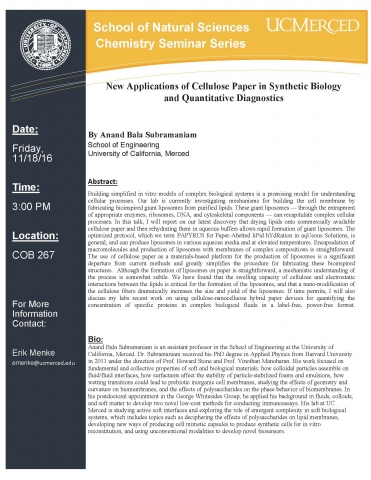
Anand Bala Subramaniam, University of California, Merced
Abstract:
Building simplified in vitro models of complex biological systems is a promising model for understanding cellular processes. Our lab is currently investigating mechanisms for building the cell membrane by fabricating bioinspired giant liposomes from purified lipids. These giant liposomes — through the entrapment of appropriate enzymes, ribosomes, DNA, and cytoskeletal components — can recapitulate complex cellular processes. In this talk, I will report on our latest discovery that drying lipids onto commercially available cellulose paper and then rehydrating them in aqueous buffers allows rapid formation of giant liposomes. The optimized protocol, which we term PAPYRUS for Paper-Abetted liPid hYdRation in aqUeous Solutions, is general, and can produce liposomes in various aqueous media and at elevated temperatures. Encapsulation of macromolecules and production of liposomes with membranes of complex compositions is straightforward. The use of cellulose paper as a materials-based platform for the production of liposomes is a significant departure from current methods and greatly simplifies the procedure for fabricating these bioinspired structures. Although the formation of liposomes on paper is straightforward, a mechanistic understanding of the process is somewhat subtle. We have found that the swelling capacity of cellulose and electrostatic interactions between the lipids is critical for the formation of the liposomes, and that a nano-modification of the cellulose fibers dramatically increases the size and yield of the liposomes. If time permits, I will also discuss my labs recent work on using cellulose-nanocelluose hybrid paper devices for quantifying the concentration of specific proteins in complex biological fluids in a label-free, power-free format.



